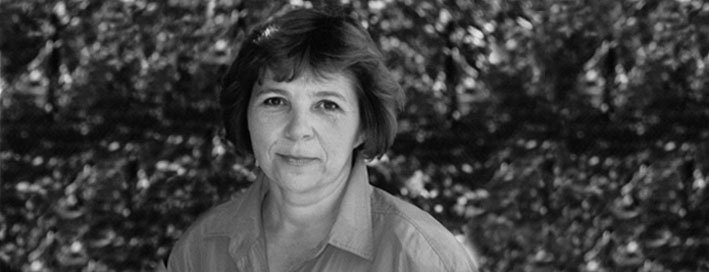Marta Ptaszyńska
Composer, percussionist, and professor of composition.

Color and Order in My Music
Excepts from the Paderewski Lecture given on October 14, 2005 in Los Angeles
Since my early childhood I have been fascinated by the logic of the digital universe, by the elegance of mathematical progressions, and, above all, by the beauty of geometric symmetries. Over time, I developed a deep passion for playing with numbers, and this interest can now be clearly seen in my music, which is often structured according to numerical and geometric ideas.
For me the secret of order and organization in music lies in mathematics of all sorts: mathematical successions, progressions, calculations, numerical constructions and transformations. Geometric symmetries and structures like the famous Pythagorean theorem also play decisive roles in the organization of my musical material.
How does this digital world operate in my music? Here are several brief examples. In my work Spider Walk for percussion solo, I employ digital constellations and numerical progressions as both audible and visible cues in the score. Here I start with a simple arithmetic progression of 1:2:3:4:5:6. This order is present in both the instrumentation ( from 1 cow-bell to 6 tom-toms) as well as the construction of rhythmic motives built out of sixteen-note groups: 1,2,3,4,5,6. In another composition of mine, the Letter to the Sun for narrator, solo frame drum and percussion quartet, a series of symmetrical rhythmic patterns continually reiterate and rotate among themselves, creating a mosaic of “kaleidoscopic” sound configurations. In my string quartet Mosaics, the basic building material consists of a number of self transposing symmetrical units. But these units are actually presented as a mosaic following the symmetries of the Pythagorean triangle. The result is a fourfold symmetry between the instrumental lines which rotate vertically and horizontally four times into new positions, creating similar, yet ever differing, results in sound. In traditional polyphonic music, such a technique is called quadruple counterpoint. The same idea of a symmetrical mosaic can be seen visually in art, as in the beautiful walls and floors of much Islamic architecture, such as the great mosque in Alhambra in Spain.
In another work of mine called Linear Constructions in Space for percussion sextet, each movement is based upon a specific geometric figure: the first movement represents a circle, the second movement represents a multitude of lines in spaces, and the third movement is constructed in the shape of a pyramid.
Yet another geometric principle evident in my music is the “Golden Mean” or the “Golden Section” based on the Fibonacci series. As did composers such as Bartok, I use it as a means of structuring form in my music, although not necessarily with mathematical precision. Artistic intuition and vision always remains a priority in building the form of each work. But proportionality is one of the qualities very important to me not only for the overall formal structure of a piece, but also within the smallest subdivisions of the smallest musical units.
Perhaps one of the most important goals in my music is the organization of pitch. I am unabashedly a “pitch composer.” Whether writing a children’s song, a percussion piece, or a symphonic work, the organization of pitch and harmonic language has always been a priority to me. For each work, I compose a separate set of pitches from which I may build a constellation of sounds using self transposing or rotating motivic cells. These constellations of sounds are generated in the course of the piece through various pitch rotations, transpositions or symmetrical pairings. In more descriptive visual language, they may be compared to moving galaxies with their own internal gravities, centrifugal forces, points of rest, and so forth. Harmonic layers and chordal structures are often derived from the use of a particular pitch set or scale. For each composition a new, individual harmonic plan is created. This plan includes not only the structure of chords, but also the specific harmonic progressions which produce characteristic colors and timbres.
Some sounds and harmonic structures seem to convey to my mind some characteristic colors. This means quite literally that while hearing a particular sound structure, I mentally “see” specific colors and shapes. It is more an intuition and almost spiritual feeling on my own part as a composer.
Color in my music is conveyed mainly by harmonic means. For me, a very strong sense of color corresponds to chord structures and their harmonic configurations. Looking e.g. at a painting of Wassily Kandinsky, Yves Tanguy, Max Ernst or Paul Klee, I am able to hear music which I feel already exists in a painting in its “frozen state” or as an immobile form. I associate such painting with harmonic colors, with specific arrangements of sounds, structures, rhythmic designs, and overall musical form. Obviously, my compositions are not literal descriptions of the paintings, but rather, purely musical reactions inspired from viewing these paintings.
My music starts from inspiration and intuition, but it can only be realized and finished through technical procedures based on the use of logic and technique.
Marta Ptaszyńska